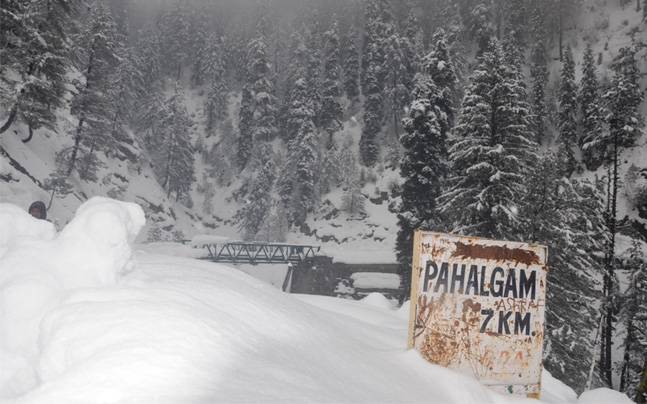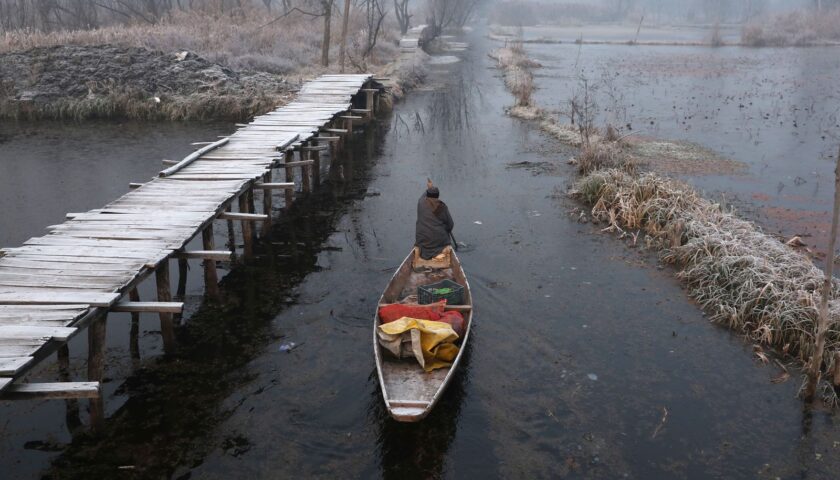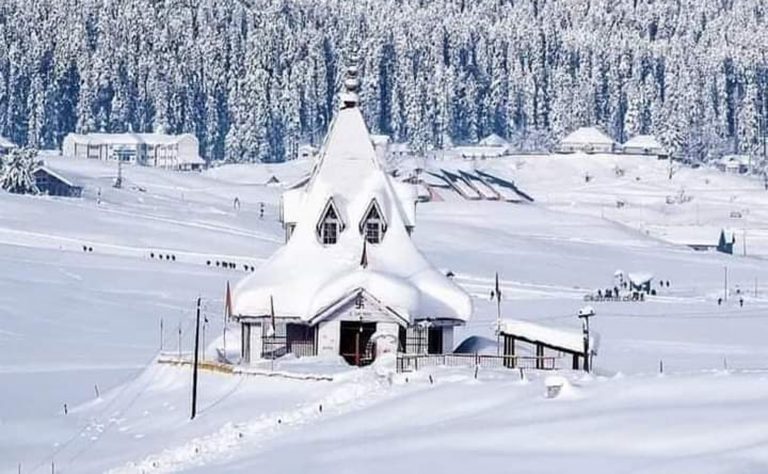The beauty of early snow is undeniable, but Kashmir’s shifting weather patterns reveal a deeper story—one of breathtaking landscapes, fragile livelihoods, and climate uncertainty.
By: Javid Amin | 07 October 2025
Winter comes early, and the valley reacts
On crisp mornings in Srinagar and the valleys beyond, an early snowline rewrites the season. Within days of rain and a sharp fall in temperatures, meadows that usually glitter in autumnal gold turned to silver: Gulmarg’s slopes, Pahalgam’s meadows, Daksum’s oak pockets and the intimate Aru Valley were dusted with snow. Tourists posted reels and photos; hoteliers hurried to ready boilers and beds; shopkeepers sold boots and thermals.
But alongside the romance, operational realities appeared: high passes closed, highways blocked intermittently by landslides, and farmers in Pir Panjal watched unripe maize and waterlogged saffron beds shiver under frost. The event must be read as two stories in one: the postcard and the precautionary note. This longform feature probes both — the visual delight and the cascading vulnerabilities — while cross-checking ground reports and official advisories.
The snowfall: places, scale and ground confirmation
Where the snow fell
-
Gulmarg, Sonamarg, Pahalgam, Aru Valley, Daksum, Chandanwari, Kokernag, and high passes including Pir Ki Gali and Zojila recorded measurable snowfall or snow flurries over the first week of October. Multiple national and local outlets reported accumulations in higher reaches and snowfall-related closures.
How heavy was it?
Local eye-witnesses and reporting indicate light to moderate accumulations in hill stations (a few inches to under a foot in some saddles), while higher pass zones saw enough buildup to disrupt traffic. These were typical “first snow” conditions that, while not record-breaking in depth, were significant because of their timing — early October, instead of the more usual late October–November onset.
Weather drivers — why now?
A strong western disturbance moving east across the Himalayan belt brought moisture and cooling aloft. Add to that a climatological nudge toward La Niña conditions for the October–December period — and you have a recipe for earlier, more frequent snowfall in the western Himalayas. IMD forecasting bulletins flagged heightened probability of La Niña and active western disturbances in this window.
Travel & Transport
Mughal Road: a scenic route shut, BRO clears the way
The historic Mughal Road — traversing Peer Ki Gali over the Pir Panjal — was closed when snow and slush made the high stretch hazardous. The Border Roads Organisation (BRO) launched snow-clearance operations and kept updates on opening windows, but the closure impacted local connectivity and smaller trade movements. The closure is a reminder that scenic mountain routes are also fragile links, and clearing them requires both machinery and safe weather windows.
NH-44 (Jammu–Srinagar highway)
NH-44 — Kashmir’s lifeline — experienced multiple weather-induced stoppages: shooting stones, mudslides, and flash slush created blockades in Ramban and Banihal sectors. Reports described stranded vehicles, blocked convoys and blasting/clearance work by highway crews. In several patches movement was restored under traffic control; in others the highway remained fragile until rockfall mitigation and clearance were completed.
Zojila and Srinagar–Leh link
The Srinagar–Leh highway, especially Zojila Pass, saw snow and low visibility warnings that prompted convoy movements and temporary suspensions. The high altitude and steep topography make this route particularly sensitive to early snow. Tourists seeking Ladakh access were cautioned to confirm road status before travel.
Real-time travel advice
-
Prefer daytime travel across mountain passes; nights increase risk.
-
Check traffic advisories from J&K Traffic Police, BRO and NHAI before departure.
-
If driving, carry chains/traction aids, warm clothes and a charged phone/power bank.
-
For scheduled flights, confirm with carriers as visibility and runway clearing can delay flights.
Tourism: instant beauty, slow bookings
The immediate tourist reaction
Early snow electrified travel feeds. Influencer posts, honeymoon queries, and weekend-trip interest spiked for Gulmarg, Pahalgam and Aru Valley — especially for short, scenic stays and snow-viewing drives. JKL Travels and other operators reported surges in inquiries and pivoted to offer short, heated-stay packages and snow treks.
Reality check: bookings convert slowly
Despite the buzz, confirmed long-stay bookings lagged in many resorts for several practical reasons:
-
Road uncertainty: closures and landslides made travellers wary of committing.
-
Infrastructure: some ski-rental and heating services were still ramping up.
-
Price & timing: airfare and hotel dynamic pricing rose; many prefer to wait for more stable windows later in the season.
Hotels in Gulmarg and Pahalgam reported occupancy upticks (some properties hitting 40–50%), but the numbers varied and were below the full surge that a sustained winter would bring.
How operators adapted
Tour operators quickly repackaged “autumn-snow” offers: 48-hour snow-view escapes, heated lodge nights, photography tours and weekend ski-experience introductions. Flexible booking terms — refunds, date-changes — became essential to persuade cautious travellers.
Opportunity vs risk for tourism
An extended snowy winter could be a boon: early slopes, longer ski seasons, and increased winter spending. But infrastructure, reliable connectivity and safe operations must match the demand. The window is an opportunity only if authorities and operators coordinate (road clearing, air service reliability, safety messaging).
Agriculture & livelihoods: Pir Panjal’s bitter slide
Who is affected, and how
The Pir Panjal belt (Rajouri, Poonch, parts of Shopian and the Thanamandi area) reported unseasonal heavy rains and early frost, which damaged:
-
Late-standing maize and vegetable crops (lodging, rot)
-
Apples and walnuts nearing harvest — bruising and lower sugar content risks
-
Saffron beds susceptible to waterlogging and bulb damage
Farmers described frantic harvesting attempts and losses where crops couldn’t be salvaged. Local agri-extension teams have begun rapid assessments; early field visits suggest localized losses that may be significant for smallholders.
Economic ripple
Kashmir’s horticulture and vegetable sectors rely heavily on autumn harvests. Losses now reduce household incomes through winter and create supply deficits for local markets. For saffron — a high-value crop — damage risks can depress yields and revenue for entire growing seasons if bulbs are harmed.
Institutional response
Agricultural departments are:
-
Conducting field surveys to estimate damage percentages.
-
Reviewing compensation and crop insurance claims under state disaster funds or central schemes.
-
Issuing advisories for frost protection (covering, mulching, quick harvest).
A rapid, transparent compensation approach and targeted emergency support (labour, temporary storage, transport) will be essential to prevent long-term distress.
Health, heating and community stress
Rising energy & heating demand
Colder, early winters mean heating demand spikes. Power distribution companies (district PDDs/KPDCL) prepare load management plans, but outages and transformer failures are common stress points in heavy snow/wind seasons. Households rely on traditional bukharis (wood/coal), LPG and newer electric heating where available.
Health services on alert
Early winters correlate with surges in respiratory illnesses, influenza, and cold-related emergencies (hypothermia). Health centers in remote areas can be cut off during snowstorms – so community health preparedness (stocked clinics, mobile health units, telemedicine) helps reduce mortality and morbidity.
Public safety measures
Authorities should emphasise:
-
Proper ventilation with bukharis to avoid carbon monoxide poisoning.
-
Safe winter cooking/heating practices, especially in enclosed rooms.
-
Vaccination / awareness drives for influenza where applicable.
Climate context and La Niña: the bigger picture
La Niña explained briefly
La Niña — cooler Pacific sea surface temperatures — alters global atmospheric circulations. For parts of India, La Niña often increases winter chill and can enhance western disturbances that deliver precipitation (including snow) to the western Himalayas. IMD bulletins have flagged a higher probability of La Niña influence in the October–December 2025 window.
Why this matters for Kashmir
-
Earlier, heavier snow: can lengthen the winter tourism season but increases disruption risk.
-
Increased frost days: elevates crop vulnerability and heating needs.
-
Infrastructure stress: more frequent weather extremes test roads, power and emergency response.
Climate change overlay
Longer-term climate change complicates the picture: while La Niña is a natural oscillation, background warming and altered precipitation patterns can amplify extremes — heavier downpours before a sudden frost, or unusual warm spells followed by deep cold snaps. Adaptive planning must therefore be both short-term (this season) and structural (resilience investments).
Cross-verified facts and sources
To avoid rumor and ensure accuracy, this piece cross-checked multiple sources and official advisories:
-
Snowfall reports across Gulmarg, Pahalgam, Aru, Sonamarg and other high reaches — national and local outlets and wire reports.
-
Mughal Road closure and BRO snow clearance operations — BRO / NewsonAir coverage.
-
NH-44 disruptions and landslide reports — local outlets and highway updates.
-
Farmers’ damage reports in Pir Panjal (Rajouri, Poonch, Shopian) — local press & field assessments reported in regional news.
-
La Niña likelihood and IMD guidance — IMD forecasts and national analyses.
Practical preparedness checklist
For residents & households
-
Inspect & service heating systems now.
-
Keep emergency fuel, blankets and medicines ready.
-
Seal windows/doors and insulate water pipes to avoid freezing.
-
Prepare a small emergency kit for power outages (lights, batteries, power bank).
For farmers & pastoralists
-
Accelerate harvesting where possible; prioritize perishable crops.
-
Use coverings or low tunnels for high-value crops like saffron and early vegetables.
-
Coordinate with extension services for emergency labour or storage.
-
Document losses (photos, witness statements) for compensation claims.
For travellers & tour operators
-
Keep bookings flexible; promote refundable/transferable packages.
-
Pre-arrange local certified transport and ensure drivers have winter experience.
-
Provide guests with safety information and emergency contact lists.
-
Keep alternate itineraries if high passes close.
For authorities & utilities
-
Pre-deploy snowploughs, heavy machinery and teams at known trouble spots.
-
Stock spare transformers and poles; pre-stage emergency repair crews.
-
Implement proactive public communication (road status dashboards, SMS alerts).
-
Enable mobile medical units for remote communities.
Policy & adaptive recommendations
-
Climate-aware agriculture policy: expand crop insurance, frost protection subsidies, and rapid compensation mechanisms.
-
Resilient road corridors: strengthen slope stabilization, early warning systems for rockfall and controlled blasting capacity to clear boulders safely.
-
Decentralised energy: microgrids and community solar/winter energy storage to reduce winter power stress.
-
Sustainable tourism blueprint: invest in all-weather access, trained winter safety workforce, local procurement to reduce supply chain fragility.
-
Integrated hazard monitoring: combine IMD forecasting, BRO road sensors and local crowd-sourced reporting for a single authoritative dashboard.
These steps move beyond short-term relief to make the region resilient to more frequent seasonal surprises.
Voices from the field
-
“Aru Valley looks magical. We’re seeing a spike in interest, but road clarity is key.” — Javid Amin, JKL Travels. (industry reports)
-
“We were preparing for harvest. Now we’re counting losses.” — Farmer, Thanamandi (regional reporting on Pir Panjal farm distress).
-
“BRO has launched clearance on Mughal Road; safety is our priority.” — BRO / NewsonAir coverage.
-
IMD / climatology experts: warn La Niña could intensify winter precip and cold spells; preparedness is advised.
Feature storytelling: a day in Pahalgam and a night in Aru
Dawn in Pahalgam: the shepherds’ dogs shake snow from their backs; kettle steam replaces morning mist. Families that had planned late-October weddings now laugh nervously as thermals and pherans are unpacked. In the Aru Valley, newlyweds sip hot noon chai in a small heated cottage, while a local guide checks the mule trails for safe snow crossings. At the same time, a farmer in Thanamandi pries his maize from mud—what should have fed a family through winter now faces rot.
This juxtaposition — lovers delighted by first snow, farmers counting losses — is Kashmir’s current seasonal truth.
FAQ & Myth-Busting
Q: Is this the start of a harsher winter than usual?
A: La Niña indications and early snowfall raise the probability of a colder, wetter winter in Kashmir, but exact intensity and timing will be dictated by interacting systems (western disturbances, local topography). Follow IMD updates. India Meteorological Department
Q: Are highways closed now?
A: Some stretches (Mughal Road at Pir Ki Gali; parts of NH-44 in Ramban/Banihal) experienced temporary closures due to snow/landslides; clearances are ongoing. Check live advisories. All India Radio News+1
Q: Can I still travel to Gulmarg / Pahalgam?
A: Day trips and short stays are possible where roads are open; confirm with local transport and hotels, and consider flexible booking options.
Q: What should farmers do now?
A: Prioritize harvest where feasible, protect high-value crops with coverings, document losses for compensation. Seek local agri-extension support.
Bottomline — a storm of beauty and warning
Kashmir’s early snowfall created pictures that will circulate for months: chinar leaves with white fur, shikaras slipping through mist-softened Dal Lake, meadows turned winter-white. But beneath that beauty is a ledger of cost: disrupted highways, anxious farmers, stressed utilities and health systems. Because La Niña looms and western disturbances remain active, this season asks for more than awe — it demands readiness.
The valley now holds two simultaneous possibilities: one in which early snow is converted into prolonged tourist prosperity and replenished water reserves; another in which crops, connectivity and community resilience are tested to the limit. The difference will be in how quickly authorities, communities, farmers and businesses pivot from being awed — to being prepared.




